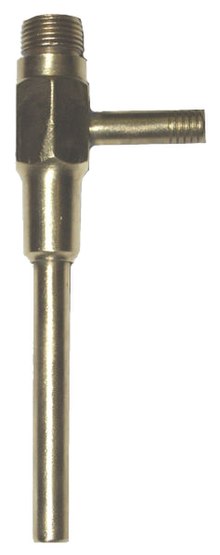
Back شفاطة (مضخة) Arabic Водна помпа Bulgarian Trompa de buit Catalan Wasserstrahlpumpe German Bomba Venturi Spanish آسپیراتور Persian Ejektori Finnish Trompe à eau French Aspirator Croatian Aspirator (pompa) ID
This article relies largely or entirely on a single source. (April 2024) |
 A brass aspirator. The water inlet and outlet are at the top and bottom, respectively; the air inlet is on the side. | |
| Other names | Eductor-jet pump, injector/ejector, filter pump, Venturi pump |
|---|---|
| Uses | Vacuum generation, suction |
| Related items | Injector, vacuum pump |
A vacuum ejector, or simply ejector is a type of vacuum pump, which produces vacuum by means of the Venturi effect.
In an ejector, a working fluid (liquid or gaseous) flows through a jet nozzle into a tube that first narrows and then expands in cross-sectional area. The fluid leaving the jet is flowing at a high velocity which due to Bernoulli's principle results in it having low pressure, thus generating a vacuum. The outer tube then narrows into a mixing section where the high velocity working fluid mixes with the fluid that is drawn in by the vacuum, imparting enough velocity for it to be ejected, the tube then typically expands in order to decrease the velocity of the ejected stream, allowing the pressure to smoothly increase to the external pressure.
The strength of the vacuum produced depends on the velocity and shape of the fluid jet and the shape of the constriction and mixing sections, but if a liquid is used as the working fluid the strength of the vacuum produced is limited by the vapor pressure of the liquid (for water, 3.2 kPa or 0.46 psi or 32 mbar at 25 °C or 77 °F). If a gas is used, however, this restriction does not exist.
If not considering the source of the working fluid, vacuum ejectors can be significantly more compact than a self-powered vacuum pump of the same capacity.
© MMXXIII Rich X Search. We shall prevail. All rights reserved. Rich X Search